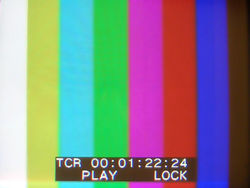
Burnt-in timecode
Encyclopedia

Human-readable
A human-readable medium or human-readable format is a representation of data or information that can be naturally read by humans.In computing, human-readable data is often encoded as ASCII or Unicode text, rather than presented in a binary representation...
on-screen version of the timecode information for a piece of material superimposed on a video image. BITC is sometimes used in conjunction with "real" machine-readable timecode, but more often used in copies of original material on to a non-broadcast format such as VHS, so that the VHS copies can be traced back to their master tape and the original time codes easily located.
Many professional VTRs can "burn" (overlay) the tape timecode onto one of their composite
Composite video
Composite video is the format of an analog television signal before it is combined with a sound signal and modulated onto an RF carrier. In contrast to component video it contains all required video information, including colors in a single line-level signal...
outputs. This output (which usually also displays the setup menu or on-screen display
On-screen display
An on-screen display is an image superimposed on a screen picture, commonly used by modern television sets, VCRs, and DVD players to display information such as volume, channel, and time.-History:...
) is known as the super out or monitor out. The character switch or menu item turns this behaviour on or off. The character function is also used to display the timecode on the preview monitors in linear editing
Linear video editing
Linear video editing is a video editing post-production process of selecting, arranging and modifying images and sound in a predetermined, ordered sequence. Regardless whether captured by a video camera, tapeless camcorder, recorded in a television studio on a video tape recorder the content must...
suites.
Videotapes that are recorded with timecode numbers overlaid on the video are referred to as window dubs, named after the "window" that displays the burnt-in timecode on-screen.
Timecode can also be superimposed on video using a dedicated overlay device, often called a "window dub inserter". This inputs a video signal and its separate timecode audio signal, reads the timecode, superimposes the timecode display over the video, and outputs the combined display (usually via composite), all in real time. Stand-alone timecode generator / readers often have the window dub function built-in.
Some consumer cameras, in particular DV cameras, can "burn" (overlay) the tape timecode onto the composite output. This output typically is semi-transparent and may include other tape information. It is usually activated by turning on the 'display' info in one of the camera's sub-menus. While not as 'professional' as an overlay as created by a professional VCRs, it is a cheap alternative that is just as accurate.
Timecode is stored in the metadata areas of captured DV AVI files, and some software is able to "burn" (overlay) this into the video frames. For example, DVMP Pro is able to "burn" timecode or other items of DV metadata (such as date and time, iris, shutter speed, gain, white balance mode, etc.) into DV AVI files.
Some modern editing systems can use OCR
Optical character recognition
Optical character recognition, usually abbreviated to OCR, is the mechanical or electronic translation of scanned images of handwritten, typewritten or printed text into machine-encoded text. It is widely used to convert books and documents into electronic files, to computerize a record-keeping...
techniques to read BITC in situations where other forms of timecode are not available.
BITC can also be referred to as Viz-Code.
See also
- Linear timecodeLinear timecodeLinear Timecode is an encoding of SMPTE timecode data in an audio signal, as defined in SMPTE 12M specification. The audio signal is commonly recorded on a VTR track or other storage media. The bits are encoded using the biphase mark code, also known as "FM": a zero bit has a single transition...
- Vertical interval timecodeVertical interval timecodeVertical Interval TimeCode is a form of SMPTE timecode embedded as a pair of black-and-white bars in a video signal. These lines are typically inserted into the vertical blanking interval of the video signal...
- SMPTE time codeSMPTE time codeSMPTE timecode is a set of cooperating standards to label individual frames of video or film with a time code defined by the Society of Motion Picture and Television Engineers in the SMPTE 12M specification...
- MIDI timecodeMIDI timecodeMIDI time code , or MIDI time division, embeds the same timing information as standard SMPTE timecode as a series of small 'quarter-frame' MIDI messages. There is no provision for the user bits in the standard MIDI time code messages, and SysEx messages are used to carry this information instead...
- CTL timecodeCTL timecodeCTL timecode, developed by JVC in the early 1990s, is a unique technique for embedding, or striping, reference SMPTE timecode onto a videotape....
- AES-EBU embedded timecodeAES/EBUAES3 is the standard used for the transport of digital audio signals between professional audio devices. It is also known as AES/EBU and is published by the Audio Engineering Society and as part of IEC 60958. It was developed by the AES and the European Broadcasting Union and first published in...
- Rewritable consumer timecodeRewritable consumer timecodeThe Rewriteable Consumer Timecode is a nearly frame accurate timecode method developed by Sony for 8mm and Hi8 analog tape formats. The RC timecode is written by the video camera directly to analog tape tracks and records the hour, minute, second and frame for each frame of video recorded to tape...

